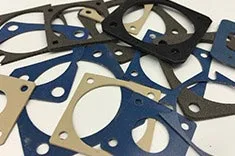EMI Shielding Products
- Custom Gasket Fabrication
- Connector Gaskets
- Bonded O Ring
- Custom Gaskets
- Conduct-O-Knit Knitted Wire Mesh
- Conduct-O-Seal Combo Gasket
- Conduct-O-Elastomer
- Conduct-O-Seal Oriented Wire in Silicone Gasket Material
- Conduct-O-Mesh Tape
- Conduct-O-Foam
- Conduct-O-Bond
- Optical Filters For Electronic Displays
- Shielded Vent Panels
- ESC Board Level Shielding
- 300 Series
Effective EMI Shielding: The Role of Reflection
 Electromagnetic Interference (EMI) shielding is critical to maintaining the performance of electrical instruments by reducing the unwanted dispersion of electromagnetic waves into protected spaces. The primary role of EMI shielding is reflection. This mechanism, which is central to the effectiveness of various shielding materials, is of paramount importance for professionals in the field of EMI shielding, providing them with a comprehensive understanding of this crucial aspect of their work.
Electromagnetic Interference (EMI) shielding is critical to maintaining the performance of electrical instruments by reducing the unwanted dispersion of electromagnetic waves into protected spaces. The primary role of EMI shielding is reflection. This mechanism, which is central to the effectiveness of various shielding materials, is of paramount importance for professionals in the field of EMI shielding, providing them with a comprehensive understanding of this crucial aspect of their work.
The Core Mechanism: Reflection
Reflection is the foremost mechanism for EMI shielding. A material must possess mobile charge carriers, such as electrons or holes, for adequate reflection and interaction with electromagnetic radiation. Metals are the most common materials used for this purpose due to the abundance of free electrons. These free electrons reflect electromagnetic waves, thus preventing interference.
Highly conductive materials are particularly effective at shielding electromagnetic waves through reflection. Conductivity enhances the reflection mechanism, making materials like copper, aluminum, and other metals preferred choices for EMI shielding.
Enhancing Reflection with Conductive Materials
While conductivity is not a strict requirement for EMI shielding, it significantly enhances the reflection capability of shielding materials. This principle underlies the widespread use of metals in EMI shielding applications. With their high electrical conductivity, metals such as copper and aluminum play a crucial role in this process. They provide a robust barrier against electromagnetic waves, reflecting them and preventing interference with electronic devices. Understanding and leveraging this role of conductivity empowers professionals in the field of EMI shielding.
Factors Influencing Reflection Efficiency
Several factors determine the efficiency of reflection-based EMI shielding.
- Material Conductivity: Higher conductivity materials reflect more electromagnetic waves.
- Thickness of the Shield: Thicker materials enhance the shielding effectiveness by providing more surface area for reflection.
- Surface Properties: Smooth and continuous surfaces reflect better than rough or discontinuous ones.
Application in Modern EMI Shielding Solutions
Modern EMI shielding solutions confidently leverage the reflection mechanism. For example, conductive polymer composites are gaining attention due to their processability and cost-effectiveness. These composites incorporate conductive fillers like carbon nanotubes, graphene, and metal nanoparticles, which provide the necessary mobile charge carriers for adequate reflection. This widespread use of the reflection mechanism in modern solutions reassures professionals in the field of EMI shielding about the effectiveness of their work.
- Automotive Industry: Thin metal sheets shield electronic components in vehicles from EMI, ensuring the reliable operation of sensitive electronics.
- Consumer Electronics: Electronics use conductive coatings and enclosures to prevent EMI from affecting performance. Some examples of these devices are smartphones and laptops.
- Aerospace: Aircraft employ extensive EMI shielding to protect avionics and other critical systems from interference, ensuring safety and functionality.
Critical Factors for Maximizing Shielding Effectiveness
Reflection is the cornerstone of effective EMI shielding. Materials with high electrical conductivity can significantly enhance shielding effectiveness. This mechanism is widely utilized across various industries, from automotive to aerospace, to ensure electronic devices function in the presence of electromagnetic interference.
Engineers and EMI shielding professionals must understand and optimize the reflection mechanism. By focusing on materials and designs that maximize reflection, superior EMI protection can be achieved while maintaining electronic systems' integrity and performance.



